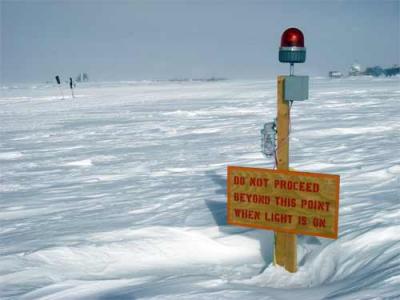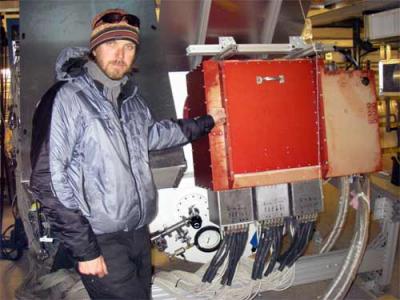At the beginning of my stay, I had the privilege to see the largest telescope of that kind on earth. It is called the South Pole Telescope and it has a reflector of 10 meters in diameter. Helmuth Spieler, one of the principal investigators, presented to me his research and showed me the telescope earlier, when one of its main part: the cryostat was still to be put together.
To get to the telescope, one has to go to the "Dark Sector” of the station, about ½ mile away from the main station. It is called "Dark Sector” because no external light initiated by humans is allowed in the section during the winter and summer time. In order to get there, one has to cross the ski-way (run –way). When the "Beacon” is on, one is NOT allowed to cross the ski-way, because a plane might be leaving or arriving.
The beacon signal before the ski way

Crossing the ski-way (run-way).
 Crossing the ski-way (run-way). The dark flags designate the runway boarders. They will be taking down during the winter.*
Crossing the ski-way (run-way). The dark flags designate the runway boarders. They will be taking down during the winter.*
Helmuth Spieler and Elke Bergholz in front of the South Pole Telescope

Potter and Spieler in front of the SPT.
 Don Potter (not related to Harry Potter) who helped to build the telescope and Helmuth Spieler, one of the Principal Investigator in front of the South Pole telescope (SPT).*
Don Potter (not related to Harry Potter) who helped to build the telescope and Helmuth Spieler, one of the Principal Investigator in front of the South Pole telescope (SPT).*
It took 2 years to build the telescope at the South Pole. Prior to that it was put together in Texas and then taken apart in the order it was to be built under South Pole conditions. All parts had to be brought to the South Pole by plane (LC 130). The largest part was 25 000 pounds. This is the largest load the "Herc” can carry. (The C17 can carry 125 000 pounds, however it can not land at the South Pole.)
What is the mission of the South Pole Telescope.? The SPT is detecting the Cosmic Microwave Background, (CMB).
Essentially, the telescope is looking back to the time 400 000 years after the "Big Bang”. Imagine searching for energy that originated 400 000 years after the "Big Bang”! This is truly looking back in time. Since I start most of my classes with the chemical evolution, I appreciate knowing that atoms have been around for 300 000 years. A Quarks particle is the oldest particles. Protons, Neutrons followed, forming the nuclei of an atom. Further on in the chemical evolution, molecules formed, and eventually organic molecules and eventually life as we know it developed.
Now imagine going back in time detecting the energy before atomic particles as we know it existed!! That is what the telescope is trying to detect in order to understand the evolution of the universe, the evolution of matter, maybe the discovery of other galaxy clusters!
What evidence are we looking for? If we are going back in light years to find evidence of the "Big Bang” then the universe was more condense and therefore "hotter”. The South Pole Telescope is trying to detect this change in energy.
How is this possible? First, the reflector is 10 meters in diameter and can detect much more of a range of incoming energy. It also has an improved focal point with less deviation. It can detect energy information of 20 micrometer apart; compare that to the diameter of a hair of 100 micrometer!
The reflector relays the energy to the detector.
The reflector of the South Pole telescope
 The detector relays the energy to superconductors, called SQUID.*
The detector relays the energy to superconductors, called SQUID.*
Helmuth Spieler is working on the super-conductors

In order to detect such energy, the cosmic microwave background, all other background energy has to be filtered out. This is achieved by super-cooling the superconductors inside a cryostat to a temperature of 0.25 Kelvin (Kelvin is the absolute temperature, zero Kelvin = minus 217.15. Celsius. In other words, if we cool all atoms then their movement will be very limited, eliminating possible energy given off and we detected only the energy we are interested in.
The Cryostat is build
 Dana Hrubes and Brad Benson are building the cryostat. Dana will winter-over again to take care of the telescope.*
Dana Hrubes and Brad Benson are building the cryostat. Dana will winter-over again to take care of the telescope.*
The completed cryostat
 Martin is standing next to the completed cryostat. This red part contains the superconductors with the connections to the detector. Martin is a grad-student and is getting his PhD soon.*
Martin is standing next to the completed cryostat. This red part contains the superconductors with the connections to the detector. Martin is a grad-student and is getting his PhD soon.*
How is the cooling achieved? First, a pulse-tube-cooler will bring the first white part of the cryostat to 4 to 5 Kelvin. In order to cool the superconductors (in the red box) down to less than 1 Kelvin, the Helium 10 system is used, a system that lowers the boiling point of Helium 4 and 3.
Cryostat at 4 Kelvin
 Dana and Martin are standing in front of the 4-Kelvin-Cryostat*
Dana and Martin are standing in front of the 4-Kelvin-Cryostat*
J. Dana Hrubes will report about his winter work at the South Pole.
Yuki Takahashi, a graduate student from Berkeley University also works with a telescope. However, he is working with a smaller refractor telescope that detects the cosmic microwave background energy to study the very first moment of the "Big Bang" called "inflation".
Yuki in front of his telescope.

BICEP collaboration plate for visitors
 Yuki displayed the collaboration plate for visitors. He also would like to invite everyone who has questions to write him an email at:*
Yuki displayed the collaboration plate for visitors. He also would like to invite everyone who has questions to write him an email at:*
yukimoon at berkeley. edu
I went back with Dana and Martin last Thursday to the SPT since I missed the demonstration of moving the telescope while we had visitors.
The gear of the telescope
 Imagine that the SPT will be moved with this gear!*
Imagine that the SPT will be moved with this gear!*
Observing the movement of the SPT
 Elke and Dana were observing the movement of the SPT. I never thought it would move that fast.*
Elke and Dana were observing the movement of the SPT. I never thought it would move that fast.*
Answer to yesterday’s question of: what kind of science did Paul Siple conducted at the South Pole during the IGY: through out the Antarctic continent, including at the South Pole, meteorology, the aurora and airglow, glaciology, ionospheric physics, seismology, cosmic rays, gravity, geomagnetism and other physical phenomena were studied.
Question: How did Paul Siple communicate with the rest of the world during the IGY?

